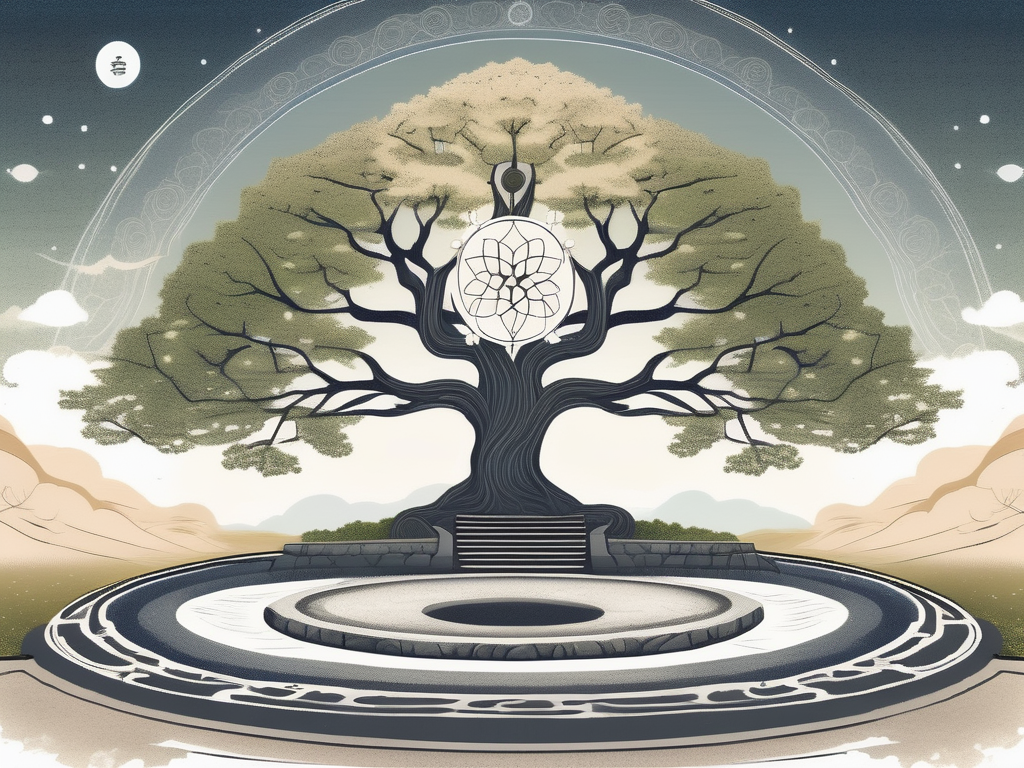Enlightenment is a fundamental concept in Buddhism, and it holds great significance in the spiritual journey of a Buddhist practitioner. In this comprehensive guide, we will explore the various aspects of enlightenment in Buddhism, including its definition, historical context, the path to achieving it, the stages of enlightenment, the role of meditation, and dispelling common misconceptions. Let’s dive into this profound topic and unravel the mysteries of enlightenment in Buddhism.
Understanding the Concept of Enlightenment
At its core, enlightenment in Buddhism refers to the attainment of ultimate wisdom and liberation from the cycle of suffering and rebirth. It is the highest state of consciousness, where one gains profound insight into the true nature of reality and transcends the limitations of ego and ignorance. The concept of enlightenment is deeply rooted in the teachings of the Buddha and forms the central goal of Buddhist practice.
Enlightenment is not a destination that can be reached through external means, but rather an inner journey of self-discovery and transformation. It involves a deep understanding of the interconnectedness of all things and the recognition that our actions have consequences not only for ourselves but for the entire world. This realization brings about a profound shift in one’s perception and behavior, leading to a more compassionate and ethical way of living.
Defining Enlightenment in Buddhism
Enlightenment, in Buddhist terms, is often described as the realization of the Four Noble Truths and the embodiment of the Eightfold Path. The Four Noble Truths are the fundamental teachings of Buddhism that address the nature of suffering, its causes, and the path to liberation. The Eightfold Path, on the other hand, is a set of ethical guidelines and practices that lead to the cessation of suffering and the attainment of enlightenment.
Enlightenment is not a one-time event, but an ongoing process of deepening wisdom and compassion. It is a state of being that is cultivated through meditation, mindfulness, and the cultivation of virtuous qualities such as generosity, kindness, and patience. It is through these practices that one gradually unravels the layers of delusion and ignorance, leading to a direct experience of the true nature of reality.
The Historical Context of Enlightenment
The concept of enlightenment has its roots in the historical context of ancient India during the time of the Buddha. Siddhartha Gautama, the historical Buddha, was born into a royal family and lived a life of luxury and privilege. However, he became disillusioned with the superficiality and impermanence of worldly pleasures and embarked on a spiritual quest to seek the truth.
After years of rigorous practice, meditation, and self-inquiry, Siddhartha Gautama achieved enlightenment under the Bodhi tree. It is said that he gained deep insights into the nature of suffering, the causes of suffering, and the path to liberation. These insights formed the basis of his teachings, which he shared with others for the remainder of his life.
The teachings of the Buddha spread throughout India and eventually reached other parts of Asia, where they took root and evolved into different schools and traditions. The concept of enlightenment became central to these various Buddhist traditions, each offering its own unique perspectives and practices for attaining liberation.
Today, the quest for enlightenment continues to be a central focus of Buddhist practitioners around the world. While the path may vary from person to person and from tradition to tradition, the goal remains the same – to awaken to the true nature of reality and to live a life of wisdom, compassion, and freedom from suffering.
The Path to Enlightenment in Buddhism
While enlightenment may seem like an elusive goal, Buddhism provides a structured path to guide individuals on their spiritual journey. This path consists of the Four Noble Truths and the Eightfold Path, which together offer a comprehensive framework for self-transformation and awakening.
Buddhism, one of the world’s oldest religions, has long been revered for its profound teachings on the nature of existence and the path to liberation. The Four Noble Truths and the Eightfold Path form the core of Buddhist philosophy, providing practitioners with a roadmap to navigate the complexities of life and attain enlightenment.
The Four Noble Truths
The Four Noble Truths are the essential teachings that outline the nature of suffering, its causes, and the path to liberation. They serve as the foundation upon which the entire Buddhist tradition is built. Let’s explore each truth in more detail:
- Dukkha: The truth of suffering, acknowledging the inherent unsatisfactoriness and impermanence of existence. This truth reminds us that life is filled with ups and downs, and that true happiness cannot be found in external circumstances alone.
- Samudaya: The truth of the origin of suffering, recognizing that desire and attachment are the root causes of suffering. By clinging to our desires and attaching ourselves to transient things, we create a cycle of craving and dissatisfaction that leads to suffering.
- Nirodha: The truth of the cessation of suffering, understanding that liberation from suffering is attainable through the elimination of desire and attachment. This truth offers hope and encourages practitioners to cultivate detachment and let go of their cravings, leading to a state of inner peace and freedom.
- Magga: The truth of the path to the cessation of suffering, following the Eightfold Path as the means to liberation. This truth emphasizes the importance of following a structured path to attain enlightenment, and the Eightfold Path serves as the roadmap for this transformative journey.
The Eightfold Path
The Eightfold Path encompasses eight interconnected practices that cultivate wisdom, ethical conduct, and mental discipline. It is called the Middle Way, as it avoids the extremes of indulgence and asceticism. Let’s delve deeper into each aspect of the Eightfold Path:
- Right View: Developing a correct understanding of the nature of reality and the Four Noble Truths. This involves seeing things as they truly are, without delusion or distortion, and recognizing the impermanence and interconnectedness of all phenomena.
- Right Intention: Cultivating wholesome intentions and aligning them with the principles of compassion and non-harm. This aspect of the path encourages practitioners to cultivate a genuine desire to alleviate suffering, both for themselves and others, and to act with kindness and empathy.
- Right Speech: Practicing truthful, kind, and skillful communication. This aspect emphasizes the importance of using our words wisely, avoiding falsehoods, divisive speech, harsh language, and idle chatter. Instead, we should strive to communicate in a way that promotes understanding, harmony, and goodwill.
- Right Action: Engaging in ethical conduct through actions that promote well-being and refrain from harm. This aspect encourages practitioners to abstain from actions that cause harm to oneself or others, such as killing, stealing, and engaging in sexual misconduct. Instead, we should cultivate actions that promote peace, compassion, and generosity.
- Right Livelihood: Choosing a livelihood that is morally upright and supports the path of awakening. This aspect encourages practitioners to engage in work that is honest, ethical, and aligned with their spiritual values. It reminds us that our livelihood should not cause harm or contribute to the suffering of others.
- Right Effort: Cultivating wholesome qualities and making a continuous effort to abandon unwholesome mental states. This aspect emphasizes the importance of cultivating positive qualities such as mindfulness, compassion, and patience, while actively working to let go of negative qualities such as greed, hatred, and ignorance.
- Right Mindfulness: Developing present-moment awareness and mindfulness of body, feelings, mind, and phenomena. This aspect encourages practitioners to cultivate a deep awareness of their experiences in the present moment, without judgment or attachment. It involves observing the mind and body with clarity and non-reactivity, leading to a deeper understanding of oneself and the nature of reality.
- Right Concentration: Cultivating deep states of concentration through meditation practices. This aspect involves training the mind to focus and settle, leading to states of deep concentration and tranquility. Through the practice of meditation, practitioners can develop a calm and focused mind, which is essential for gaining insight and realizing the true nature of existence.
The Stages of Enlightenment in Buddhism
Enlightenment is not a singular event but a progressive unfolding of insights and transformations. Buddhism identifies several stages of enlightenment, each marking a significant milestone on the spiritual path.
Stream-Entry
Stream-entry is the initial stage of enlightenment and marks the first glimpse of the ultimate truth. At this stage, individuals have a direct experience of the impermanent and selfless nature of reality. They begin to understand that everything in the world is in a constant state of flux, and that there is no permanent self or essence to be found. This realization brings a profound sense of liberation and freedom from the attachments and illusions that bind us.
Stream-enterers have firmly established faith in the Buddha, Dharma, and Sangha, and have eradicated the first three fetters that bind them to the cycle of birth and death. These fetters include the belief in a permanent self, doubt about the teachings, and attachment to rituals and practices as a means of salvation. By breaking free from these limitations, stream-enterers embark on a path of continuous growth and transformation.
Once-Returner
Once-returners have progressed further on the path towards enlightenment. They have weakened the attachment to sensual desires and have diminished the ego’s hold on them. Through deep contemplation and meditation, they have developed a deeper understanding of the causes and effects of suffering. They have gained insight into the interconnectedness of all beings and the impermanence of all phenomena.
The once-returner is expected to be reborn only once more before attaining enlightenment. They have significantly reduced their emotional and mental defilements, such as anger, greed, and ignorance. Their minds are clearer and more focused, allowing them to cultivate compassion and wisdom in their daily lives. Once-returners continue to deepen their practice, purifying their hearts and minds, and moving closer to the ultimate goal of liberation.
Non-Returner
Non-returners have reached an advanced stage on the path to enlightenment. They have severed the bonds of sensual desire and attachment completely. They are free from the cravings and clinging that cause suffering. Non-returners have transcended the lower realms of existence and are no longer subject to rebirth in those realms.
Having let go of all unwholesome states of mind, non-returners are characterized by their purity and equanimity. They have cultivated deep insight into the nature of reality and have developed profound wisdom and compassion. Non-returners are fully dedicated to the path of liberation and are determined to attain enlightenment in their current lifetime.
Arahant
Arahants are the fully awakened beings who have attained the highest level of enlightenment. They have eradicated all defilements and have completely transcended the cycle of rebirth. Arahants have purified their minds to such an extent that they are free from all forms of suffering and delusion.
These enlightened beings embody the highest virtues of wisdom, compassion, and moral conduct. They are a source of inspiration and guidance for all beings on the path to liberation. Arahants have realized the ultimate truth and have attained a state of profound peace and liberation that is beyond words and concepts.
It is important to note that the stages of enlightenment are not linear or fixed. Each individual progresses at their own pace, and the experiences and insights gained can vary. The path to enlightenment is a lifelong journey of self-discovery, self-transformation, and deepening wisdom.
The Role of Meditation in Achieving Enlightenment
Meditation plays a crucial role in the path to enlightenment, as it provides the foundation for self-awareness, concentration, and insight. In Buddhism, two primary forms of meditation are emphasized: insight meditation (Vipassana) and tranquility meditation (Samatha).
Insight Meditation (Vipassana)
Insight meditation involves a profound investigation into the nature of reality and the impermanence of all phenomena. By developing mindfulness and awareness, practitioners develop a deep understanding of the true nature of existence, thereby dismantling the illusion of a fixed and separate self.
Tranquility Meditation (Samatha)
Tranquility meditation cultivates calmness, concentration, and tranquility of mind through the cultivation of specific meditation objects such as the breath or loving-kindness. By calming the mind and reducing distractions, practitioners gain stability and inner peace, which provide a conducive environment for deepening insight.
Misconceptions about Enlightenment in Buddhism
Enlightenment in Buddhism is often shrouded in misconceptions, which can hinder one’s understanding and practice. Let’s address some common misunderstandings:
Enlightenment as a Sudden Experience
Contrary to popular belief, enlightenment is not an instant, magical experience that occurs out of the blue. It is a gradual and progressive path of self-transformation, characterized by diligent practice, self-reflection, and a deepening understanding of the teachings.
Enlightenment and the Concept of Self
Enlightenment involves transcending the illusion of a fixed and separate self. It is not an affirmation or reinforcement of the self but a dissolution of the ego and the realization of interconnectedness with all beings and phenomena. Enlightenment fosters the recognition that the ego’s boundaries are illusory and that true liberation lies in embracing the interdependent nature of existence.
Conclusion
Enlightenment holds immense significance in Buddhism as the ultimate goal of spiritual practice. By understanding the concept, following the path, and engaging in meditation, individuals can embark on a transformative journey towards liberation and profound wisdom. Let go of misconceptions, delve into the teachings, and embark on this awe-inspiring quest to unveil the true nature of existence – the path towards enlightenment in Buddhism.












